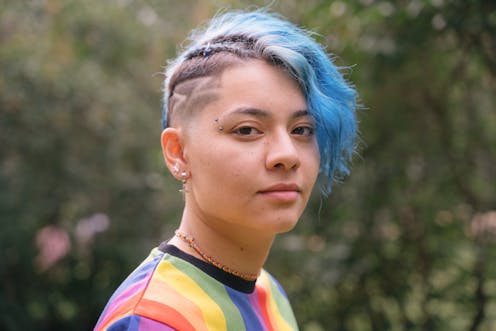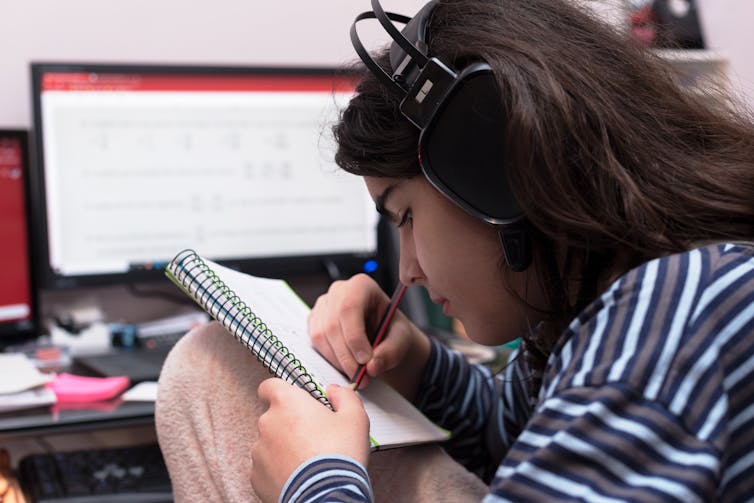Source: The Conversation (Au and NZ) – By Cristyn Davies, Research Fellow in Child and Adolescent Health, Faculty of Medicine and Health, University of Sydney

All children and adolescents have the right to live free from discrimination. However, the public debate last week around the proposed religious discrimination bill threatened this right.
While the bill has been shelved, the debate is a continuation of a discussion in which the existence, rights, and lives of trans children and adolescents have been called into question both in Australia and overseas.
These young people have endured intensified stigma and discrimination that negatively impacts their health and well-being.
Poorer health outcomes
Trans people make up between 2.3% to 3.7% of Australia’s youth population.
Although many trans people live healthy, fulfilled lives, research from overseas shows a disproportionate number have poorer mental health than their peers.
Recent Australian studies paint a similar picture. One study found:
- 90% of trans young people experienced high or very high psychological distress in the previous four weeks
- 54% had self-harmed
- 71% reported suicidal ideation
- 14% had attempted suicide in the preceding 12 months
- 38% reported having attempted suicide at some point in their life.
Read more:
Almost half of trans young people try to end their lives. How can we reduce this alarming statistic?
Another study found trans young people in Australia were 15 times more likely to attempt suicide than the general population.
Minority stress
Minority stress arises from the social, psychological and structural discrimination associated with belonging to a stigmatised minority group.
Negative media commentary can directly contribute to minority stress among trans people, as can legislation and policies that seek to exclude trans individuals from schools and workplaces.
Negative representations of trans children and adolescents in the media shape public attitudes and practices. This can not only stoke fear and mistrust that further marginalises trans young people, but also lead to violence against them.

Shutterstock
In Australia, one study found 89% of trans young people had experienced peer rejection. Some 74% had experienced bullying, while 69% had experienced discrimination.
Another study found 68% of trans young people in Australia had felt uncomfortable or unsafe in their educational setting because of their gender or sexuality diversity.
A third study found young trans Australians were four times more likely to have experienced sexual violence or coercion.
Public debate about trans young people also impacts their families. For instance, a recent study reported parents of trans children and adolescents in the United States experienced significant stress as a result of legislation introduced to prevent young trans people accessing medical and surgical gender affirmation.
Not surprisingly, parents viewed these bills as increasing stigma towards their child and the broader trans community.

Shutterstock
Health harms of public debate
Apart from fostering stigma and discrimination, public debate about trans people can also negatively impact their health.
Physical activity in adolescence is important for long-term health. Trans young people already experience multiple barriers to participating in sport and physical activity. Public commentary questioning involvement of trans people in sport acts as a further obstacle.
Negative press coverage about affirmative health care for trans young people has also been associated with reduced referral rates to specialist paediatric gender clinics overseas, and highlights the role public debate is likely to play in reducing access to such care.
Read more:
Why the way we approach transgender and non-binary healthcare needs to change
Finally, trans young people report exposure to negative news stories adversely affects their mental health by provoking experiences of depression, anxiety, and/or fear.
So what can we do to help?
Strikingly, previous research has shown when trans young people are supported and their gender is affirmed, they have similar mental health outcomes to their cisgender peers.
While parental support no doubt plays a key role, emerging evidence indicates having safe and supportive schools is critical too.
School safety and connectedness, for example, are protective factors against depression, self-harm, and suicide.
Similarly, peer and school support provide a buffer against the negative impact of gender-related victimisation on mental health.
Policies and procedures that enable a trans young person’s gender, name and pronouns to be accurately recorded are also important. Research shows having identity documents that match one’s affirmed gender is associated with lower rates of serious psychological distress and suicide.
Read more:
What are gender pronouns and why is it important to use the right ones?
Finally, the media itself may help to promote better health for trans young people. For instance, trans adolescents have reported experiencing happiness and increased hope after exposure to positive news reports about other trans people.
Trans young people flourish with support from family, friends, and the broader community. Hopefully, future commentary about trans young people’s rights takes this into account.
![]()
Cristyn Davies reports voluntarily being co-chair of the Human Rights Council of Australia; co-chair of the Child and Youth Special Interest Group for the Public Health Association of Australia; an ambassador to Twenty10 Incorporating the Gay and Lesbian Counselling Service of New South Wales; and a member of the Australian Professional Association for Trans Health (and its research committee).
Alessandra Chinsen does not work for, consult, own shares in or receive funding from any company or organisation that would benefit from this article, and has disclosed no relevant affiliations beyond their academic appointment.
Ken Pang is a paediatrician at the Royal Children’s Hospital in Melbourne. He receives research funding from the Australian National Health and Medical Research Council, the Royal Children’s Hospital Foundation, and the Hugh D T Williamson Foundation. He is a member of the Australian Professional Association for Trans Health (and its research committee).
Rachel Skinner is a paediatrician in Adolescent Medicine at Sydney Children’s Hospital Network and Senior Clinical Advisor in Youth and Wellbeing at the NSW Ministry of Health. She holds research funding from the Australian National Health and Medical Research Council. She is a member of the Australian Association for Adolescent Health; the Australian Professional Association for Trans Health, the Society for Adolescent Health and Medicine and the World Professional Association for Transgender Health.
Kerry H. Robinson does not work for, consult, own shares in or receive funding from any company or organization that would benefit from this article, and has disclosed no relevant affiliations beyond their academic appointment.
– ref. Yes, words can harm young trans people. Here’s what we can do to help – https://theconversation.com/yes-words-can-harm-young-trans-people-heres-what-we-can-do-to-help-176788







